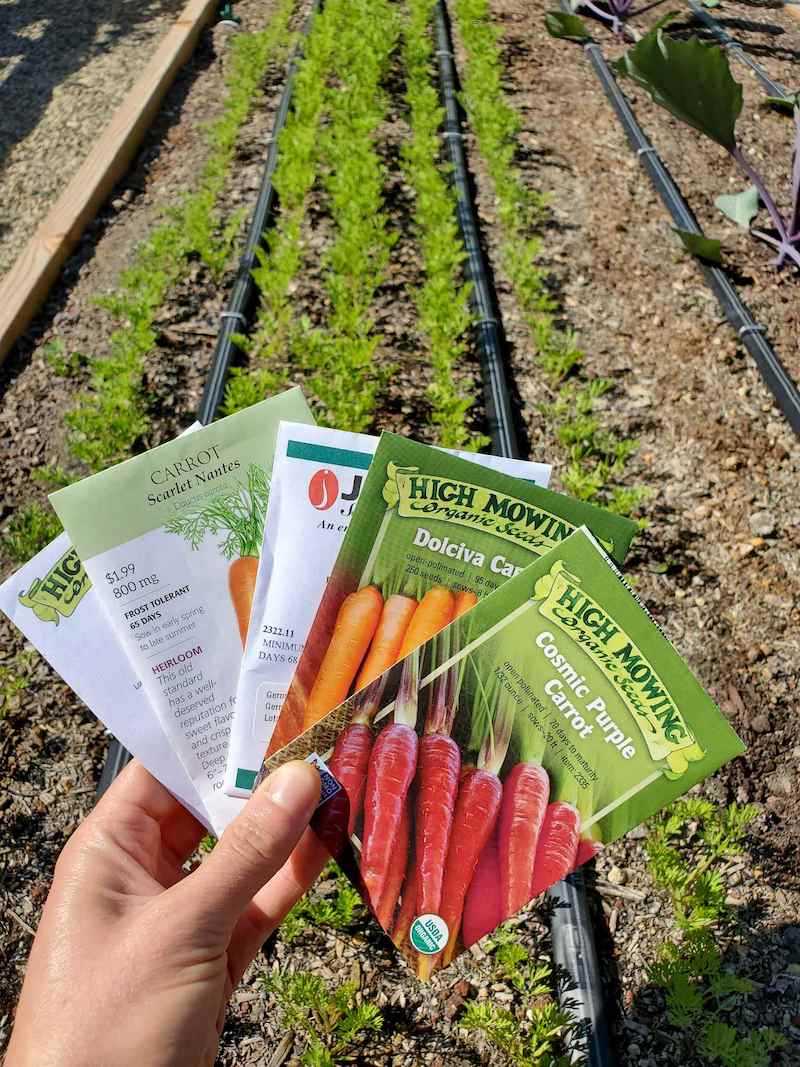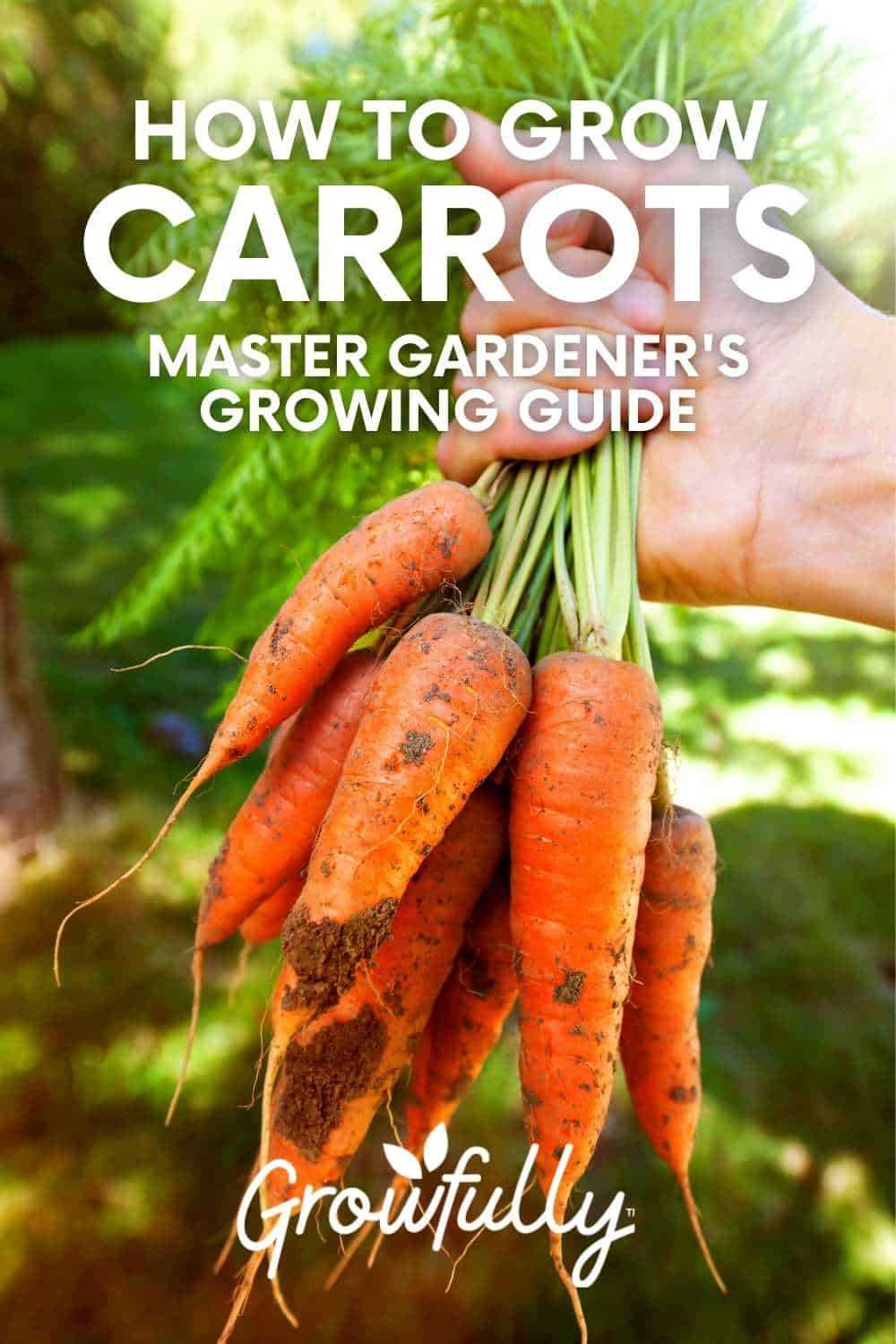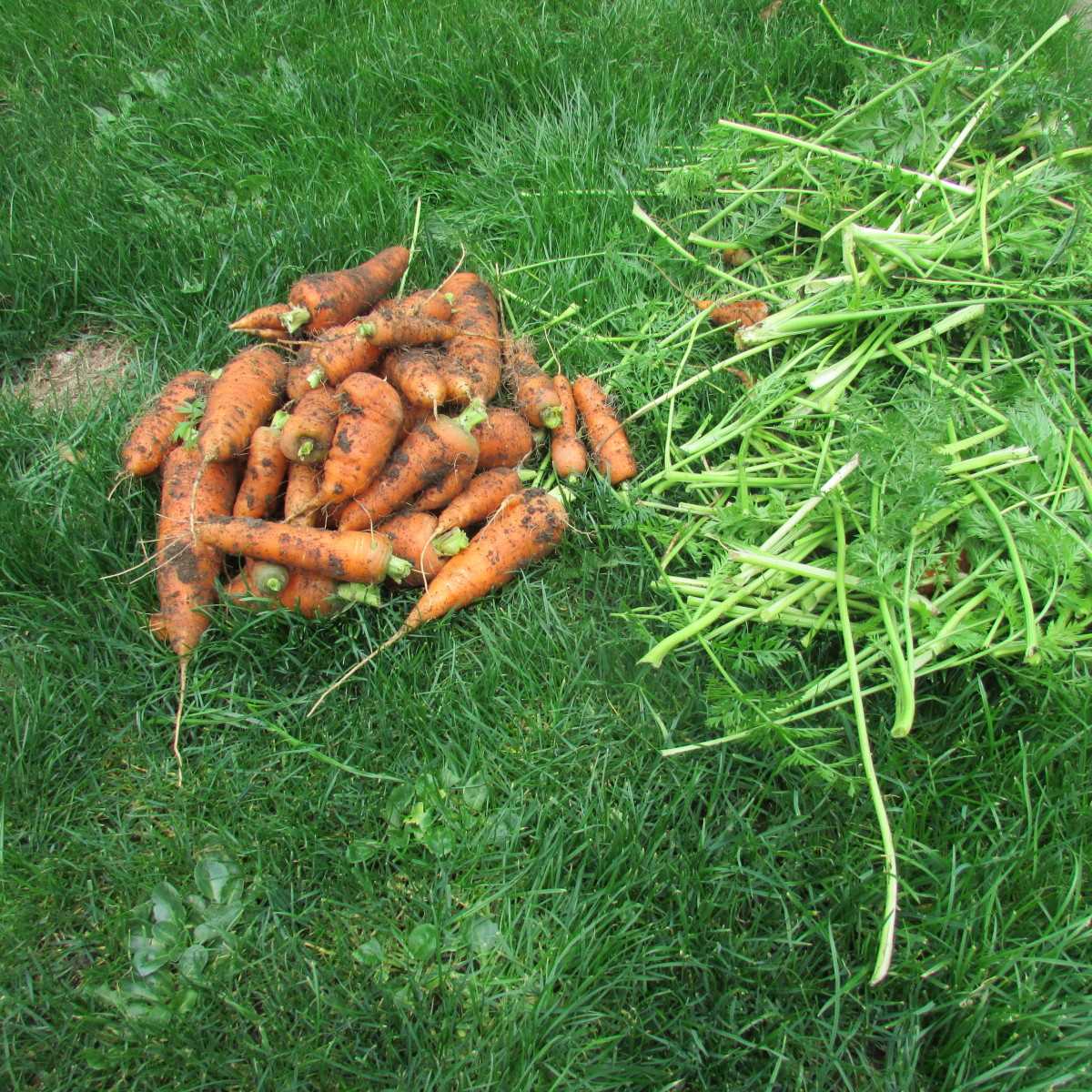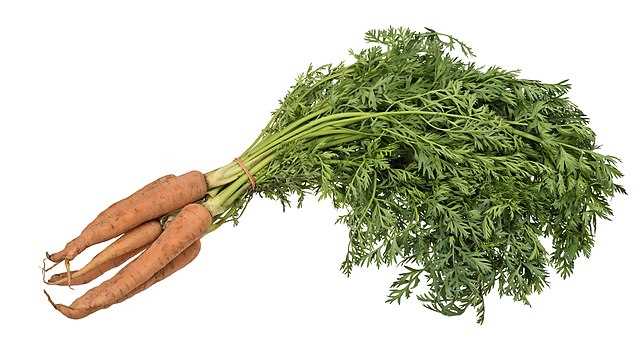- Tips for Successful Carrot Growth
- 1. Choose the right variety
- 2. Prepare the soil properly
- 3. Sow the seeds at the right depth
- 4. Thin out seedlings
- 5. Provide consistent moisture
- 6. Protect against pests
- 7. Harvest at the right time
- 8. Store carrots properly
- Importance of Soil Preparation
- Choosing the Right Carrot Varieties
- Growing Season
- Size and Shape
- Color
- Adaptability
- Seed Quality and Sowing
- Factors to Consider when Choosing Seeds
- Sowing Process
- The Module Sowing Method
- Advantages of Module Sowing:
- Steps for Module Sowing:
- Proper Watering and Irrigation
- 1. Watering Frequency
- 2. Deep Watering
- 3. Watering Method
- 4. Morning Watering
- 5. Mulching
- 6. Drip Irrigation
- 7. Watering Amount
- Fertilization Techniques for Carrots
- 1. Soil Testing
- 2. Organic Matter
- 3. Balanced Fertilizer
- 4. Side Dressing
- 5. Mulching
- 6. Watering
- 7. Avoid Excessive Fertilization
- Pest and Disease Control
- Pests
- Diseases
- Preventive Measures and Treatments
- “Question-Answer”
- What is the module sowing method for growing carrots?
- Why is the module sowing method recommended for growing carrots?
- How do you sow carrots using the module sowing method?
- What are the benefits of using the module sowing method for growing carrots?
- Can the module sowing method be used for other vegetables?
- How long does it take for carrot seeds to germinate using the module sowing method?
- “Video” How to Sow Carrots Seeds (The simple trick to good germination every time!) | Gardening Tips
If you want to grow large, juicy, and healthy carrots, then the module sowing method is the way to go. This innovative technique has revolutionized carrot farming by increasing the yield and quality of the harvest. Whether you are a professional farmer or a home gardener, the module sowing method will help you achieve the best results.
The module sowing method involves sowing carrot seeds in individual modules or cells, providing them with the perfect growing conditions. Each module contains a single seed, which allows for optimal spacing and reduces the need for thinning. This method ensures that each carrot has enough space to develop fully and prevents competition for nutrients and water.
The modules can be made from biodegradable materials such as coconut coir or peat, or they can be plastic cells that are reusable. The choice of module material depends on your preference and environmental considerations. Whichever material you choose, make sure it provides good drainage and retains moisture to support the growth of healthy roots.
Tip: Before sowing the carrot seeds in the modules, it is essential to prepare the soil properly. Carrots prefer loose, well-drained soil, so make sure to remove any rocks, weeds, or clumps of dirt. Adding organic matter such as compost or well-rotted manure will improve soil fertility and provide the necessary nutrients for carrot growth.
Once the modules are filled with prepared soil, it’s time to sow the carrot seeds. Follow the instructions on the seed packet for the recommended planting depth and spacing. Make sure to water the modules gently after sowing to ensure good seed-to-soil contact. Place the modules in a sunny spot or provide artificial light if growing indoors.
This module sowing method has several advantages. It allows for better control of pests and diseases as each module acts as a barrier. It also allows for continuous harvesting, as you can sow new modules every few weeks to ensure a constant supply of fresh carrots. Additionally, the module sowing method makes it easier to rotate crops and manage the overall garden layout.
So, if you want to grow large, juicy, and healthy carrots, give the module sowing method a try. With proper soil preparation, careful sowing, and regular maintenance, you’ll be rewarded with a bountiful carrot harvest that will delight your taste buds and impress your friends and family.
Tips for Successful Carrot Growth
1. Choose the right variety
When selecting carrot seeds, choose a variety that is well-suited to your climate and growing conditions. Some varieties are better suited to colder climates, while others thrive in warmer regions. Consider factors such as soil type, sunlight exposure, and average temperatures when selecting your carrot variety.
2. Prepare the soil properly
Carrots grow best in loose, well-drained soil. Before planting, remove any rocks, debris, or weeds from the area. Loosen the soil with a garden fork or tiller, and amend it with compost or well-rotted manure to improve its fertility and drainage.
3. Sow the seeds at the right depth
Carrot seeds should be sown at a depth of about 1/4 to 1/2 inch. Planting them too deep may result in poor germination. Use a ruler or your finger to make shallow furrows in the soil, and sprinkle the seeds evenly along the furrows. Cover them lightly with soil and gently firm the soil surface.
4. Thin out seedlings
Once the carrot seedlings have emerged, they need to be thinned out to allow proper root development. Thin the seedlings to a spacing of about 2 inches apart. Crowded seedlings will compete for resources and result in stunted carrots.
5. Provide consistent moisture
Carrots need consistent moisture to grow properly. Keep the soil evenly moist, but avoid overwatering, as this can lead to rot and disease. Mulching around the carrot plants can help retain moisture in the soil and regulate temperature.
6. Protect against pests
Carrots are susceptible to pests such as carrot flies and nematodes. To protect your crop, consider using floating row covers, which act as a physical barrier to keep pests away. Regularly inspect your plants for signs of pest damage and take appropriate measures if necessary.
7. Harvest at the right time
Carrots are ready to harvest when their roots have reached a desirable size. This usually occurs about 60-80 days after planting, depending on the variety. Gently loosen the soil around the base of the carrot, grasp the foliage near the root, and pull the carrot out of the ground.
8. Store carrots properly
After harvesting, remove the foliage from the carrots and store them in a cool, dark, and humid place. Carrots can be stored in a refrigerator or a root cellar for several months. Proper storage conditions are essential to maintain their quality and prevent spoilage.
| Problem | Solution |
|---|---|
| Carrots with forked roots | Improve soil structure and avoid rocky or compacted soil. |
| Bitter-tasting carrots | Plant carrot varieties that are less prone to bitterness and avoid high nitrogen fertilizers. |
| Carrot fly infestation | Use floating row covers to protect the plants or employ companion planting techniques with strong-smelling herbs. |
| Poor germination | Ensure the soil is not too compacted and keep the soil consistently moist during the germination period. |
Importance of Soil Preparation

Soil preparation is a critical step in growing large, juicy, and healthy carrots. The quality of the soil directly affects the growth and development of the carrots. Here are some reasons why soil preparation is important:
- Nutrient Availability: By preparing the soil properly, you ensure that it is rich in nutrients that carrots require for optimal growth. Carrots are heavy feeders and need a well-balanced supply of nutrients like nitrogen, phosphorus, and potassium.
- Improved Water Retention: Proper soil preparation helps improve the water-holding capacity of the soil. Carrots need consistent moisture levels to develop properly. Adequate water retention ensures that the carrots’ roots can access water during dry periods.
- Optimal Drainage: Carrots prefer well-draining soil to avoid rot and other diseases caused by waterlogged conditions. Proper soil preparation helps create a loose and well-aerated soil structure, enabling excess water to drain away quickly.
- Reduction in Weeds: By properly preparing the soil, you can minimize weed growth. Weeds compete with carrots for nutrients and reduce their overall growth. Adequate soil preparation can help suppress weed germination and give your carrots a better chance at thriving.
- Loose Soil Structure: Carrots require loose soil for their roots to penetrate and grow freely. By carefully preparing the soil, you create a loose, well-tilled environment that enables the carrots to develop long and straight roots.
- Pest and Disease Prevention: Proper soil preparation can help reduce the risk of pest infestation and disease. Removing debris, such as rocks and plant residues, and applying organic matter can improve the overall health of the soil and make it less attractive to pests and diseases.
By taking the time to prepare the soil before sowing carrot seeds, you can significantly increase the chances of producing large, juicy, and healthy carrots. Remember to test your soil’s pH and nutrient levels to ensure that you provide the best growing conditions for your carrots.
Choosing the Right Carrot Varieties

When it comes to growing carrots, choosing the right variety is crucial for successful cultivation. With numerous carrot varieties available, it can be overwhelming to decide which one to grow. Here are some factors to consider when selecting carrot varieties for your garden:
Growing Season

The growing season in your area is an important factor in selecting carrot varieties. Some types of carrots mature faster than others. Early maturing varieties are ready to harvest within 50-70 days, while maincrop varieties take longer, usually 70-120 days.
For gardeners with a short growing season, it is recommended to choose early maturing varieties to ensure a successful harvest before the frost arrives. On the other hand, gardeners in regions with longer growing seasons can opt for maincrop varieties.
Size and Shape
Carrot varieties come in different sizes and shapes. Some varieties produce small and round carrots, while others grow long and cylindrical roots. There are also varieties with tapered or blunt ends.
Consider the intended use of the carrots when choosing their size and shape. If you plan to use them for juicing or processing, varieties with cylindrical shapes or long roots are ideal. For fresh consumption, round or baby carrot varieties can be a great choice.
Color
Carrots are not only orange; they also come in various colors, including purple, red, yellow, and white. Each color has its own unique flavor and nutritional profile.
Choosing different colored carrot varieties can add variety to your garden and meals. Purple carrots, for example, contain anthocyanins, which are powerful antioxidants. Yellow carrots have a sweeter flavor, while white carrots are milder in taste.
Adaptability
Some carrot varieties are more adaptable to different growing conditions than others. Consider the soil type, climate, and other environmental factors in your area when choosing carrot varieties.
Check the seed packets or consult with local nurseries to find carrot varieties that are known to perform well in your specific region. These varieties are more likely to thrive and produce a bountiful harvest.
| Variety | Color | Size | Maturity |
|---|---|---|---|
| Nantes | Orange | Medium | 70 days |
| Scarlet Nantes | Orange | Medium | 70 days |
| Chantenay | Orange | Medium | 65 days |
| Imperator | Orange | Large | 75 days |
Seed Quality and Sowing
Seed quality plays a critical role in the success of sowing carrots using the module sowing method. It is important to select high-quality seeds to ensure healthy and vigorous carrot plants.
Factors to Consider when Choosing Seeds

1. Variety: There are different carrot varieties available, each with unique characteristics and requirements. Consider factors such as size, shape, color, and taste when choosing a variety suitable for your needs.
2. Freshness: Fresh seeds have a higher germination rate compared to older seeds. It is recommended to use seeds that are no more than a year old to ensure high germination rates.
3. Germination Rate: Check the seed packet or label for information on the germination rate. Higher germination rates ensure a greater chance of successful sowing and healthy plant growth.
4. Disease Resistance: Look for seeds that are resistant to common carrot diseases such as carrot fly or root rot. Disease-resistant varieties will have a higher chance of survival and produce healthy carrots.
Sowing Process

1. Soil Preparation: Prepare the soil by removing any weeds, rocks, or other debris. Carrots prefer loose and well-draining soil enriched with organic matter.
2. Seed Spacing: The module sowing method requires spacing the seeds properly for optimal growth. This can be done by creating evenly spaced rows or by using seed tapes that already have the correct spacing.
3. Seed Depth: Carrot seeds should be sown at a depth of approximately 1/4 to 1/2 inch. Ensure the soil is evenly moist during the germination period.
4. Watering: Keep the soil consistently moist during the germination and growth stages. Avoid overwatering, as it can cause the seeds to rot.
5. Thin Crowded Seedlings: Once the seedlings have emerged and grown a few inches tall, thin them out to provide enough space for proper root development. Aim for a spacing of about 2-3 inches between plants.
6. Fertilization: Carrots benefit from a light application of balanced fertilizer after thinning the seedlings. Follow the instructions on the fertilizer package for proper application rates.
7. Mulching: Apply a layer of mulch around the base of the carrot plants to help conserve moisture, suppress weed growth, and maintain steady soil temperature.
8. Regular Care: Monitor the carrots regularly for signs of pests or diseases. Remove any weeds that may compete with the plants for nutrients and water.
9. Harvesting: Harvest the carrots when they have reached the desired size and color. Gently loosen the soil around the carrots before pulling them out to avoid damaging the roots.
The Module Sowing Method
In the module sowing method, carrot seeds are sown in modules or small seed trays instead of directly into the ground. This method offers several advantages for growing large, juicy, and healthy carrots.
Advantages of Module Sowing:
- Better control over growing conditions: By sowing carrots in modules, you can create an optimal environment for germination and early growth. This includes providing the right amount of moisture, temperature, and light.
- Reduced risk of pests and diseases: Since the modules are typically kept indoors or in a controlled environment, they are less prone to attacks by pests and diseases. This helps in growing healthier carrots.
- Easier thinning and transplanting: Carrot seedlings grown in modules can be easily thinned out and transplanted without disturbing the roots of other seedlings. This allows the remaining carrots to have more space for growth and reduces competition for nutrients.
- Improved root development: The module sowing method allows each carrot seedling to develop a strong and independent root system. This leads to larger and more uniform carrots with improved flavor and texture.
Steps for Module Sowing:
- Prepare the modules: Fill small seed trays or modules with a well-draining seed compost mix.
- Sow the seeds: Sow carrot seeds thinly and evenly on the surface of the compost. Cover the seeds lightly with a thin layer of compost.
- Keep the modules moist: Water the modules gently but regularly to keep the compost moist. Avoid overwatering, as it can cause the seeds to rot.
- Provide the right conditions: Place the modules in a warm and well-lit area, such as a greenhouse or a sunny windowsill. Maintain a temperature between 60°F and 70°F (15°C to 21°C) for optimal germination.
- Thin out the seedlings: Once the seedlings have developed their first true leaves, thin them out to the desired spacing. This can be done by carefully removing the excess seedlings, leaving only one strong seedling per module.
- Transplant the seedlings: When the seedlings are about 3-4 inches (7-10 cm) tall, they can be transplanted into the garden or larger containers. Dig holes or create furrows in the prepared soil and carefully transfer the seedlings, taking care not to damage their roots.
By following the module sowing method, you can increase your chances of growing large, juicy, and healthy carrots. Give it a try and enjoy the satisfaction of harvesting your own homegrown carrots!
Proper Watering and Irrigation
To ensure that your carrots grow large, juicy, and healthy, proper watering and irrigation techniques are essential. Here are some tips to help you water your carrots effectively:
1. Watering Frequency
Carrots require consistent moisture throughout their growth cycle. It is important to water them regularly, especially during dry periods. Keep the soil evenly moist, but avoid overwatering, as it can lead to rotting and disease.
2. Deep Watering
When you water your carrots, it is crucial to provide enough water for deep root penetration. Shallow watering can cause the roots to grow close to the surface, making them more susceptible to drying out. Aim to water deeply, allowing the moisture to reach at least 6 inches below the surface.
3. Watering Method

Using a gentle and steady stream of water is recommended to avoid washing away the soil or damaging the delicate carrot seedlings. Consider using a watering can or a soaker hose for a more controlled watering method.
4. Morning Watering
Watering your carrots in the morning is ideal, as it allows the foliage to dry before nighttime. Moisture on the leaves can encourage the growth of fungal diseases. Watering early in the day also ensures that the plants have enough moisture to withstand the heat of the sun.
5. Mulching
Applying a layer of organic mulch around the carrots can help conserve moisture in the soil. Mulch acts as a barrier, preventing evaporation and reducing the need for frequent watering. It also regulates soil temperature and suppresses weed growth, keeping the carrot bed healthier and more productive.
6. Drip Irrigation
Consider using drip irrigation systems for efficient and targeted watering. Drip irrigation delivers water directly to the roots, minimizing water loss through evaporation or runoff. This method can also help prevent foliar diseases by keeping the foliage dry.
7. Watering Amount
Carrots require about 1 inch of water per week. However, the amount of water needed may vary depending on weather conditions and soil moisture levels. Monitor the moisture content of the soil regularly and adjust your watering schedule accordingly.
By following these proper watering and irrigation practices, you can provide the optimal conditions for your carrots to thrive and produce delicious and healthy harvests.
Fertilization Techniques for Carrots
Growing large, juicy, and healthy carrots requires proper fertilization techniques. Here are some techniques you can use to ensure your carrot plants receive the nutrients they need:
1. Soil Testing

Before planting your carrots, it’s essential to test your soil to determine its nutrient content. A soil test will help you identify any deficiencies and adjust the fertilizer application accordingly. You can purchase a soil testing kit from a local garden center or send a soil sample to a laboratory for analysis.
2. Organic Matter
Adding organic matter to the soil is crucial for carrot growth. Compost, well-rotted manure, or leaf mold can improve soil structure, retain moisture, and provide essential nutrients. Work the organic matter into the soil before sowing the carrot seeds to ensure even distribution.
3. Balanced Fertilizer
Carrots require a balanced fertilizer with equal amounts of nitrogen (N), phosphorus (P), and potassium (K). Look for a fertilizer with a ratio such as 10-10-10 or 14-14-14. Apply the fertilizer according to the package instructions, making sure to spread it evenly across the planting area.
4. Side Dressing
During the growth of carrot plants, you can provide additional nutrients by side dressing with a nitrogen-rich fertilizer. Apply the fertilizer in a thin line alongside the plants, taking care not to let it come into direct contact with the foliage. Incorporate the fertilizer into the soil gently with a hoe or a rake.
5. Mulching
Mulching around the carrot plants helps conserve moisture, prevent weed growth, and provide a slow release of nutrients. Use organic material such as straw, shredded leaves, or grass clippings as mulch. Apply a layer of mulch around the base of the plants, taking care not to cover the carrot tops.
6. Watering
Proper watering is essential for carrot plants to absorb and utilize the nutrients in the soil. Water consistently, making sure the soil is evenly moist but not waterlogged. Avoid overhead watering to prevent fungal diseases and focus on watering the soil directly.
7. Avoid Excessive Fertilization
While providing adequate nutrients is vital, excessive fertilization can lead to stunted growth, forked roots, or an excessive leafy canopy. Follow the recommended fertilizer rates and avoid over-fertilization that could harm the carrot plants.
By following these fertilization techniques, you can ensure your carrots receive the right nutrients for optimum growth and produce large, juicy, and healthy roots.
Pest and Disease Control
Carrots are susceptible to a variety of pests and diseases that can hinder their growth and affect their overall health. Implementing a proper pest and disease control strategy is essential to ensure the successful growth of your carrots. Here are some common pests and diseases that can affect carrots, along with preventive measures and treatments:
Pests
- Aphids: These small insects feed on the sap of carrot plants, causing stunted growth and distorted leaves. Consider using insecticidal soap or neem oil to control aphid infestations.
- Carrot Rust Fly: The larvae of this fly burrow into carrot roots, resulting in tunnels and rot. Use floating row covers to prevent the flies from laying eggs on your carrot plants.
- Wireworms: These pests are the larvae of click beetles and feed on carrot roots. Rotate crops regularly and remove any weed hosts to reduce wireworm populations.
- Carrot Weevils: These beetles lay eggs on carrot leaves, and the hatched larvae burrow into the roots. Inspect and remove any infected plants to prevent the spread of carrot weevils.
Diseases
- Root Rot: Excessive moisture and poor drainage can lead to root rot in carrots. Avoid overwatering and ensure that the soil has good drainage to prevent this disease.
- Leaf Blight: This fungal disease causes brown spots and lesions on carrot leaves. Practice crop rotation and remove any infected plants to prevent the spread of leaf blight.
- Carrot Mosaic Virus: This viral disease stunts growth and causes mosaic patterns on carrot foliage. Plant virus-free seeds and control aphid populations to prevent the spread of the carrot mosaic virus.
- Cavity Spot: This disease causes brown, sunken lesions on carrot roots. Avoid excessive fertilizer application and maintain proper soil moisture to prevent cavity spot.
Preventive Measures and Treatments
To minimize the risk of pests and diseases in your carrot crop, consider implementing the following preventive measures:
- Rotate carrot crops with non-related plants to break pest and disease cycles.
- Remove any sick or infested plants immediately to prevent the spread of pests and diseases.
- Maintain proper soil moisture to avoid excessive drying or overwatering.
- Monitor your carrot plants regularly for any signs of pests or diseases.
- Apply organic pesticides or insecticidal soaps as needed, following the product’s instructions carefully.
- Practice good sanitation by cleaning up plant debris and weeds that can harbor pests and diseases.
By implementing these preventive measures and promptly treating any pest or disease issues, you can ensure the growth of large, juicy, and healthy carrots.
“Question-Answer”
What is the module sowing method for growing carrots?
The module sowing method is a technique used for growing carrots that involves planting carrot seeds in individual modules or seed trays. This allows for better control over seed germination, root development, and transplanting.
Why is the module sowing method recommended for growing carrots?
The module sowing method is recommended for growing carrots because it allows for better control over seed germination and root development. It also makes transplanting easier since each seedling has a well-developed root system.
How do you sow carrots using the module sowing method?
To sow carrots using the module sowing method, fill individual modules or seed trays with a well-draining soil mix. Plant one carrot seed per module or cell, making sure to cover it with a thin layer of soil. Keep the modules or trays well-watered until the seeds germinate. Once the seedlings are large enough, they can be transplanted into the garden.
What are the benefits of using the module sowing method for growing carrots?
The module sowing method offers several benefits for growing carrots. It allows for better control over seed germination, root development, and transplanting. It also helps prevent overcrowding and competition among the seedlings, resulting in larger and healthier carrots.
Can the module sowing method be used for other vegetables?
Yes, the module sowing method can be used for various vegetables, not just carrots. It is particularly beneficial for crops that don’t transplant well, such as root vegetables like beets and parsnips. It can also be used for starting other crops like lettuce, cabbage, and tomatoes.
How long does it take for carrot seeds to germinate using the module sowing method?
The germination time for carrot seeds using the module sowing method depends on various factors such as the seed variety, soil temperature, and moisture levels. However, on average, carrot seeds usually take around 10-14 days to germinate under ideal conditions.







